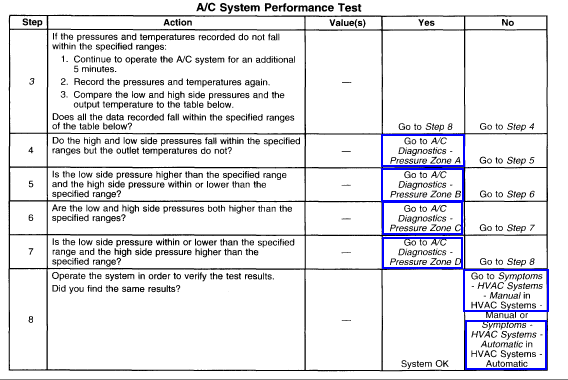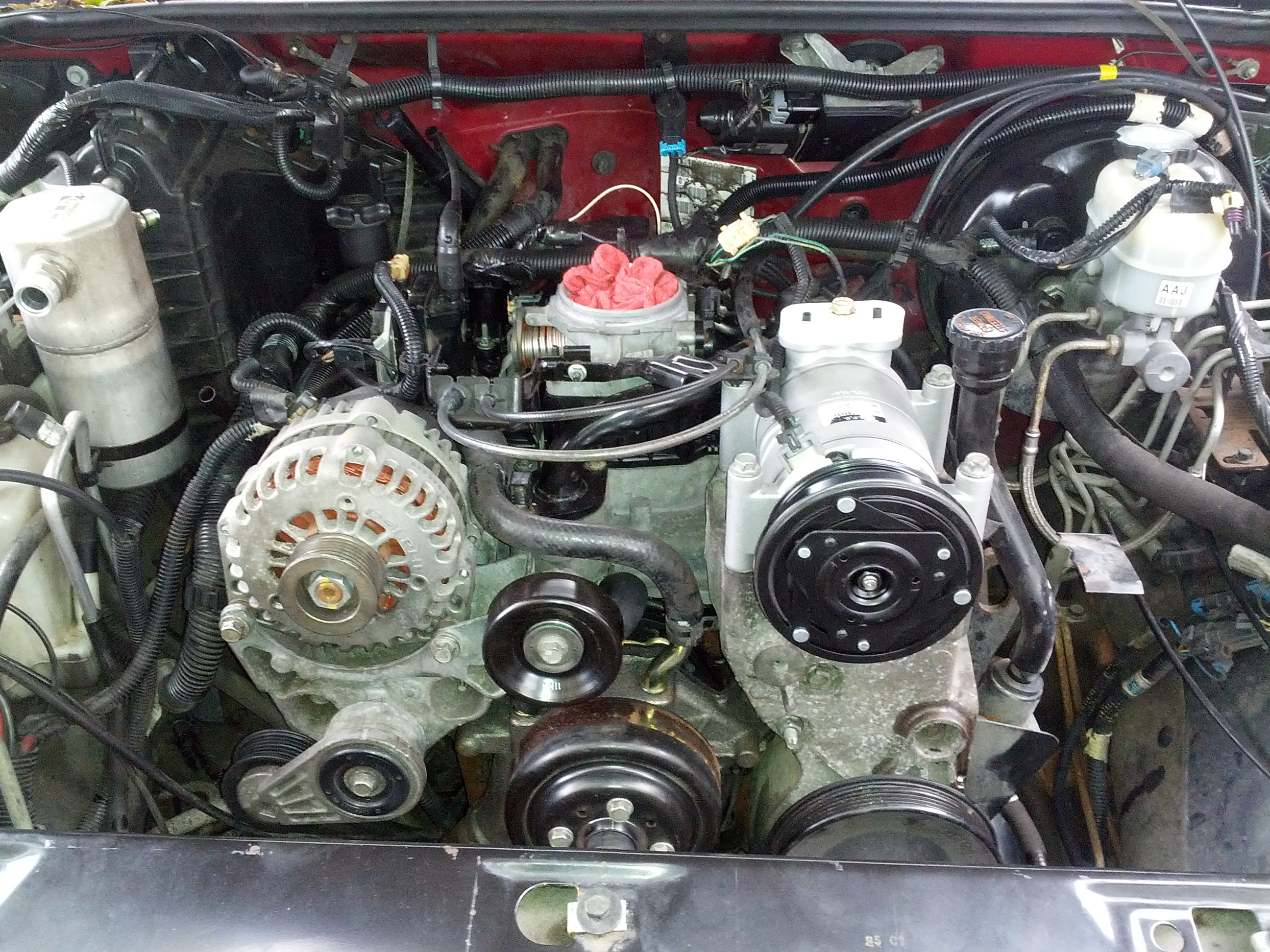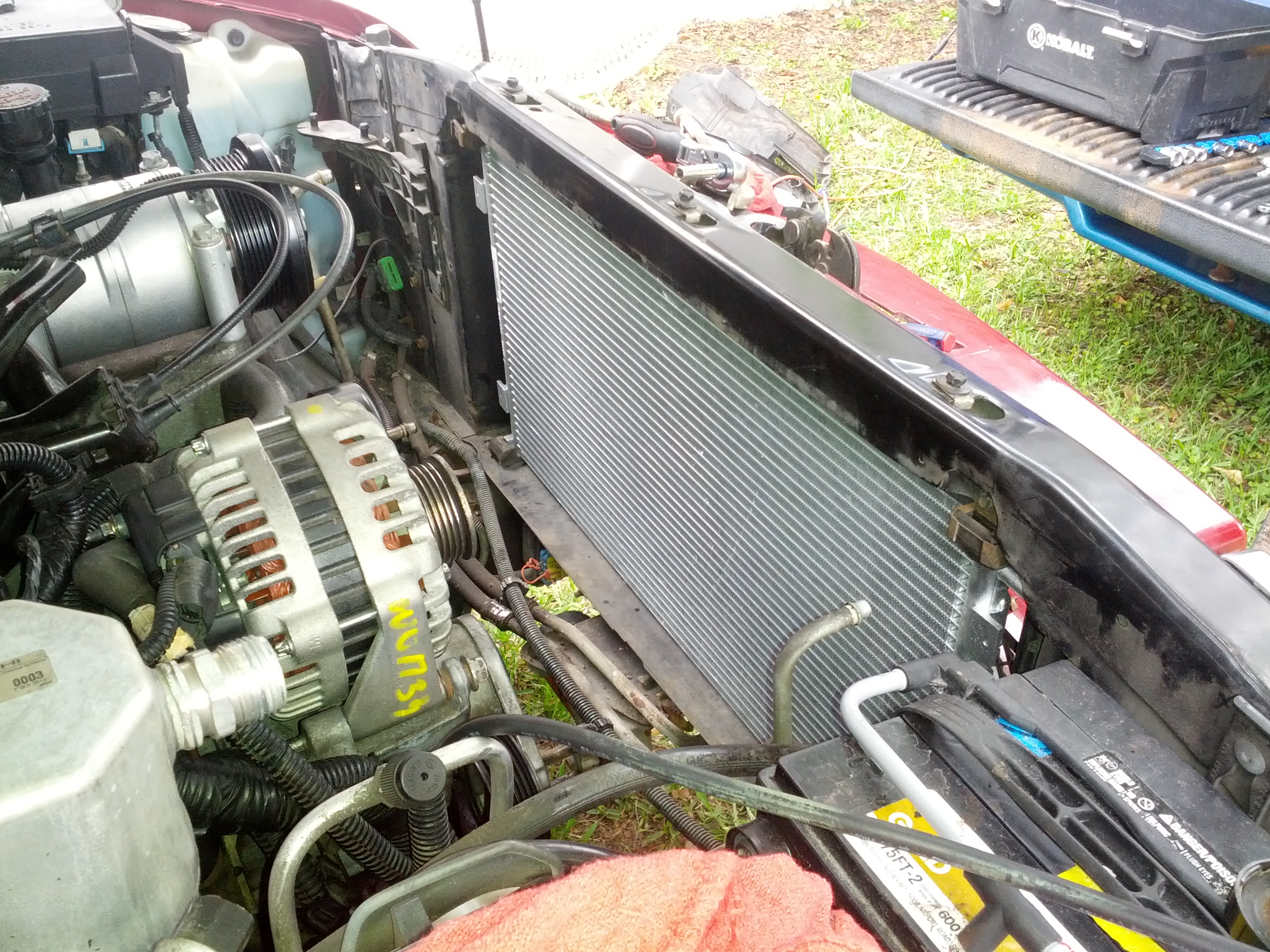Should I add freon?
#11
I added one can of Freon (actually 134a) I've got cold air back and its been back for a month!
In tryng to refill, at first the compressor would not kick on but you unplug the wire connector on the other side of the accumulator and stick a U-shaped thin wire into the holes, which tricks the computer into turning the compressor on. The compressor adds pressure on the high side, which of course makes a partial vaccuum on the low side, which enables you to load a can of 134a in there. Then take about 10 minutes to fill the system in the usual way.
I just used one can. It is cooling but I have another can, I was thinking about using half of it on another car, half on this one.
Thoughts?
In tryng to refill, at first the compressor would not kick on but you unplug the wire connector on the other side of the accumulator and stick a U-shaped thin wire into the holes, which tricks the computer into turning the compressor on. The compressor adds pressure on the high side, which of course makes a partial vaccuum on the low side, which enables you to load a can of 134a in there. Then take about 10 minutes to fill the system in the usual way.
I just used one can. It is cooling but I have another can, I was thinking about using half of it on another car, half on this one.
Thoughts?
#12
This is why I just took my car to a local shop. They charged me $120 to evacuate, test and recharge my AC. Whch sounds like a lot but they have AC machines to do the job safely and correctly. The AC systems are under extreme pressure and are filled with toxic chemicals. It is really something you should leave to a professional. I worked for a shop and have seen high pressure AC lines split open from using one of those "suicide kits" as some of the tech's called them. In some states you have to be licensed to work on AC systems, that is how dangerous it can be.
#13
The only way to know how much refrigerant is in the system, is to drain, evacuate, & recharge it with the proper amount.
Too much oil, or refrigerant, can cause over pressurization which can cause lines to blow apart, destroy the compressor, accumulator, evaporator or condenser. The weak link WILL fail, violently, very rapidly!
If the can is exposed to high side pressure, or low side pressure is too high, the can WILL explode. Look on the bottom of the can, there is a semi-circle breakaway. If it works, fine, if not, it can be lethal.
Several statements in that image are downright incorrect, which is typical for Chilton/Haynes. Don't trust it. Best to return it and get your money back ASAP. If you want a shop manual, get a genuine GM "dealer issue" manual for your year and model. Ebay usually has used ones at reasonable prices. Your Chilton/Haynes manual covers multiple years in under 200 pages. It includes incorrect and or missing information, incorrect specs, and incorrect procedures. It is "general information" not to be taken for gospel, by any means. GM shop manuals cover one year, in two or three volumes, with over 3000 pages. Sure it costs more, but you're getting correct, accurate, complete information, procedures, and specs.
Too much oil, or refrigerant, can cause over pressurization which can cause lines to blow apart, destroy the compressor, accumulator, evaporator or condenser. The weak link WILL fail, violently, very rapidly!
If the can is exposed to high side pressure, or low side pressure is too high, the can WILL explode. Look on the bottom of the can, there is a semi-circle breakaway. If it works, fine, if not, it can be lethal.
Several statements in that image are downright incorrect, which is typical for Chilton/Haynes. Don't trust it. Best to return it and get your money back ASAP. If you want a shop manual, get a genuine GM "dealer issue" manual for your year and model. Ebay usually has used ones at reasonable prices. Your Chilton/Haynes manual covers multiple years in under 200 pages. It includes incorrect and or missing information, incorrect specs, and incorrect procedures. It is "general information" not to be taken for gospel, by any means. GM shop manuals cover one year, in two or three volumes, with over 3000 pages. Sure it costs more, but you're getting correct, accurate, complete information, procedures, and specs.
At this point I would recommend waiting until it's a little hotter out and then do the performance check below. If it passes then you can stop worrying. If not, then do it right. Note the ambient air temp should be displayed on the vehicle's overhead console if you have that display. Otherwise you will have to use a scanner for the test temp. Use local weather info for the baro pressure. A dual A/C pressure guage set for R134a and A/C thermometers will be necessary. Probably you can borrow or rent them from auto parts store.



Last edited by LesMyer; 02-26-2016 at 10:03 AM.
#14
If it is not the blend door behind the dash, then is the A/C system. Here is my post from 2015 when I ended up redoing my A/C system. Lots of good info if you need to redo the system.
https://blazerforum.com/forum/2nd-ge...pressor-90114/
https://blazerforum.com/forum/2nd-ge...pressor-90114/
#15
I feel like I've either had dumb luck or it's just been shear coincidence with the 4 vehicles I've ever done AC work on... I have NEVER in my life used a vacuum, NEVER used an actual manifold gauge set, and I've recharged the AC in my 89 Jeep Cherokee, my 91 Toyota Pickup, my 95 Sonoma, 01 Totota Corolla, and COMPLETELY rebuilt the system replacing EVERYTHING but the evaporator(flushed it with an off the shelf flush in a can and some compressed air) in my 04 Blazer, have always just recharged with a hose on the low pressure port with a gauge on it a and a couple of the small cans of freon, and none of the systems ever failed me while I still had those vehicles. The Blazer will freeze you out and I haven't even touched it in 3 years... no need to, hasn't been giving me any issues!
IMO, people over think and over complicate AC systems. Yes they have a lot of components that have to work together in order for the system to work properly, but if you're willing to do a ltitle reading and can understand and grasp some basic mechanical concepts, the system is actually rather basic. It compresses, cools, and expands refrigerate, that's about it. Yeah there's a lot of variables within those steps and everything in the system has to work together, that's pretty much it.
So maybe I've just been EXTREMELY lucky, but honestly I just think that AC technicians charge way too much money for something that anyone with any mechanical know-how can do themselves but are too afraid to touch because of the horror stories that spread about cans of R134a exploding like a grenade, etc...
IMO, people over think and over complicate AC systems. Yes they have a lot of components that have to work together in order for the system to work properly, but if you're willing to do a ltitle reading and can understand and grasp some basic mechanical concepts, the system is actually rather basic. It compresses, cools, and expands refrigerate, that's about it. Yeah there's a lot of variables within those steps and everything in the system has to work together, that's pretty much it.
So maybe I've just been EXTREMELY lucky, but honestly I just think that AC technicians charge way too much money for something that anyone with any mechanical know-how can do themselves but are too afraid to touch because of the horror stories that spread about cans of R134a exploding like a grenade, etc...
#16
In addition to what has been stated above, while there is a loop hole in the EPA law that allows the sale of small cans of 134a to non certified individuals and there is some debate about the law regarding those same non certified individuals opening a sealed HVAC system (for all other refrigerants strictly forbidden for non EPA certified individuals), one thing is very clear. It is illegal to vent refrigerant into the atmosphere by anyone and the offense carries a $28K fine, and the EPA is dead serious about it. So you may have the right "touch" for topping off a leaking but otherwise functioning unit but opening one up without the proper reclaim equipment is illegal and very ill advised.
What you pay for with an AC guy is the license, the EPA certification, the training, the proper equipment (reclaim machines, vacuum pumps, gauge sets for every refrigerant and the know how to properly repair a system that is not operating properly. There are a ton of overcharged systems in every application because adding "freon" is the knee jerk reaction. An automotive system can be more forgiving than residential because of accumulators and or receivers and pressure switches but its still tough to do right without the proper equipment.
Do I understand you correctly that you opened a system to do a repair, flushed it and the just blew it out with shop air, closed it up filled with moisture and straight atmosphere, then charged it with 134a and it ran OK for years? That's the most interesting claim of all. I would have bet big money that a system that had not been evacuated and therefore charged with such a high content of non-condensables (air) and moisture would have failed. Never tried it though so I cant say for sure. Never charged a system that I didn't at least pull a vacuum down to 500 microns.
What you pay for with an AC guy is the license, the EPA certification, the training, the proper equipment (reclaim machines, vacuum pumps, gauge sets for every refrigerant and the know how to properly repair a system that is not operating properly. There are a ton of overcharged systems in every application because adding "freon" is the knee jerk reaction. An automotive system can be more forgiving than residential because of accumulators and or receivers and pressure switches but its still tough to do right without the proper equipment.
Do I understand you correctly that you opened a system to do a repair, flushed it and the just blew it out with shop air, closed it up filled with moisture and straight atmosphere, then charged it with 134a and it ran OK for years? That's the most interesting claim of all. I would have bet big money that a system that had not been evacuated and therefore charged with such a high content of non-condensables (air) and moisture would have failed. Never tried it though so I cant say for sure. Never charged a system that I didn't at least pull a vacuum down to 500 microns.
#17
I`ve emptied mine into the ozone plenty of times, and refilled it and it worked fine. And I`m willing to bet 1000s of others have also
#18
I just want to make sure that new guys that are reading this, looking for guidance don't end up thinking that decades old practices like flushing with R12 and venting into the atmosphere is OK. As I mentioned it carries a fine of $28K per event, there is a reward to turn somebody in and in 2014 the first guy got prison time for doing it so it's no joke. The EPA is very serious about this. It's not my place to tell people how to behave but I do feel compelled to put the information in front of those who are trying to learn.
George
George
#19
Do I understand you correctly that you opened a system to do a repair, flushed it and the just blew it out with shop air, closed it up filled with moisture and straight atmosphere, then charged it with 134a and it ran OK for years? That's the most interesting claim of all. I would have bet big money that a system that had not been evacuated and therefore charged with such a high content of non-condensables (air) and moisture would have failed. Never tried it though so I cant say for sure. Never charged a system that I didn't at least pull a vacuum down to 500 microns.
That is absolutely correct sir. Hell the system was open 3 or 4 days, blue show towels jammed into the holes of the evaporator to keep debris out as I was doing other things in the engine bay. Then flushed it, bolted the new parts on, charged with R134a, and enjoyed.



#20
An automotive system is more tolerant of atmospheric contamination than I thought. How long have these compressors run after a 134a fill without pulling a vacuum first?
George
George


